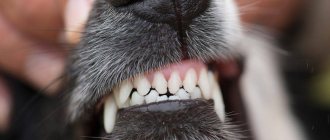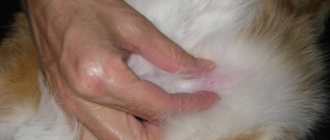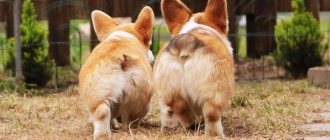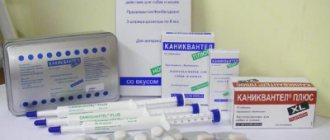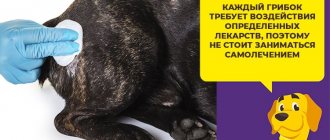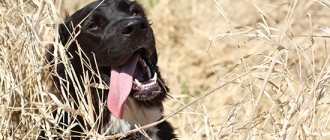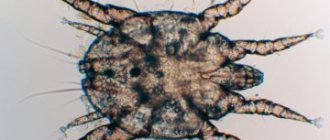Normal teeth by age
Adults
Normally, an adult dog's permanent bite consists of 42 teeth, the formula of which should look like this:
- Upper jaw: 2M 4P 1C 3I 3I 1C 4P 2M
- Lower jaw: 3M 4P 1C 3I 3I 1C 4P 3M, where:
- M - molars
- P - premolars
- C - fang
- I - incisors.
We get 20 teeth on the upper jaw and 22 on the lower jaw.
It is worth taking into account the breed characteristics of the skull. Brachycephals may have a lack of teeth, while dolichocephals (breeds with a very long muzzle, such as collies), on the contrary, may have too many. Such cases cannot be called the norm; these are simply features due to the skull.
Puppies
Puppies are born without any teeth. The first to begin to emerge are the temporary ones, or more simply put, the deciduous incisors and fangs. This occurs at 3–4 weeks of life. Then, from the fourth to the twelfth week, the “baby” premolars erupt and grow. Puppies do not have molars.
From twelve weeks until teeth change, the puppy’s formula looks like this:
- Upper jaw: 3P 1C 3I 3I 1C 3P
- Lower jaw: 3P 1C 3I 3I 1C 3P
14 teeth each in the upper and lower jaws.
The replacement of temporary teeth with permanent ones begins at three months.
At 3-5 months, the incisors completely change.
From 4 to 6 months, a complete change of incisors and premolars occurs.
And in 5-7 months molars appear.
If a puppy older than seven months still has baby teeth, take the dog to the vet.
The structure and order of teeth change
Teeth are the strongest structures in a dog’s body. They contain three substances - dentin, cement and enamel. Most of the tooth is represented by dentin, which is represented by collagen fibers, cell processes, and mineral components. Dentin is also called pulp, or the soft part of the tooth, although it is harder than bone tissue.
Externally, dentin is covered with cement and enamel. Cementum is located on the outer surface of the tooth root; it consists of 90% mineral substances. The crown is covered with the strongest organic substance – enamel. It protects the tooth from injury and ensures its rigidity. Enamel is completely devoid of cells and intercellular substance; it consists of 97% minerals.
Puppies are born without teeth. Temporary teething begins at the age of 2-3 weeks. Dogs' milk teeth are small, the crowns are small with a bluish tint to the enamel. The canines appear first, a little later - the incisors. At the age of 4-6 weeks, puppies already have all the incisors, canines and 3 premolars on each jaw. It is worth noting that premolars appear starting from the second, the first grows permanently at the age of 4-5 months.
At 4-6 months, young animals begin the process of changing teeth. This is a period of strong excitement in puppies; they begin to actively gnaw and bite everything in order to relieve discomfort in the mouth. Loose teeth can be done on your own to help your dog.
The first teeth to fall out are the deciduous incisors – these are the teeth with the shortest lifespan. In the 5th month, 2-4 premolars are replaced, and the permanent first one grows at the same time. By the end of 6-8 months, the canines are replaced, and molars begin to grow.
Dental formula of an adult dog
| Type of teeth | Upper jaw | Lower jaw |
| Incisors | 6 | 6 |
| Fangs | 2 | 2 |
| Premolars | 8 | 8 |
| Molars | 4 | 6 |
Normally, a healthy dog's jaw includes 42 teeth. In pathological conditions, some of the dog’s molars may be missing, or there may be extra ones (dewn teeth). In large breeds (mastiffs, Great Danes, Rottweilers) additional incisors are often observed.
Pathological growth and extra teeth lead to the formation of malocclusion in a dog.
The front edge of the jaws is represented by incisors - these teeth are practically not used by dogs; they perform the function of biting off small pieces of meat, plucking prey, and combing fur. To tear meat and hold prey, dogs use fangs; they follow the incisors with a small gap, which ensures the closure of the jaws. Adult dogs have only four canines. Next come the largest teeth, called molars. They include premolars and molars. Animals use them to chew solid food.
Causes of tooth loss in puppies and adults
Puppies have baby teeth for up to seven months and it is normal for them to fall out.
If the dog already has a completely permanent bite, and you notice that teeth are falling out, this is always an alarming sign and a reason to consult a veterinarian as soon as possible.
Tooth loss signals a pathological process in the dog’s body, and this is not always associated exclusively with the oral cavity.
The main reasons leading to tooth loss:
- Poor nutrition . An incorrectly formulated diet (or more often it is simply feeding from the table) is the root cause of many health problems, and oral health is no exception. Remember, your dog needs solid food! Since in the process of gnawing it, the teeth are naturally cleansed of food debris and plaque. Under no circumstances should a dog be given tubular bones. Feeding only soft foods leads to the formation of tartar, which negatively affects the condition of the tooth.
- Lack of oral hygiene.
- Oral diseases . These include:
- Gingivitis is inflammation of the gums.
- Periodontitis is an inflammation of the gums and dental follicles, affecting all surrounding tissues. The roots of the teeth are exposed.
- Pulpitis is inflammation of the dental canal (pulp).
- Stomatitis is an inflammation of the oral mucosa.
- Caries is the putrefactive destruction of hard tissues with the formation of a cavity in the affected teeth.
- Improper jaw development. This may be genetically determined, or may occur due to the lack of necessary load on the jaw. Frequent pathologies:
- Overshot - the lower jaw protrudes slightly forward relative to the upper jaw. For the Shih Tzu, Bull Terrier, Pekingese, and Boxer breeds, this phenomenon is the norm, but for other breeds it is a deviation.
- Underbite is, on the contrary, a deviation of the lower jaw backward relative to the upper jaw. If you notice this in a puppy, then most likely, after changing the teeth, everything will “fall into place.”
- Jaw misalignment is a pathology in which one of the jaws is larger than the other.
- Metabolism-related diseases . These may be hypovitaminosis, hypervitaminosis (lack or excess of vitamins), lack of macro and microelements.
- Diseases of organ systems:
- Kidney pathologies.
- Liver diseases.
- Problems in the gastrointestinal tract.
Causes of tartar formation
There may be several reasons. Let's look at some of them.
Poor nutrition
We all know that dogs are descendants of wolves. In the wild, the animal uses its teeth to catch and kill prey (this requires fangs), tear it into pieces (using incisors) and chew prey (molars). Eating solid foods (bones, cartilage) promotes self-cleaning of teeth.
At home, owners of four-legged animals often feed their pets only soft food or canned food that does not require prolonged chewing. Because of this, natural friction of solid food against the animal’s teeth does not occur and, as a result, tartar is formed.
Violation of water-salt metabolism
Some veterinarians believe that tartar in dogs occurs due to a violation of water-salt metabolism. Such a disorder may be associated with a sedentary lifestyle, hypothermia and, again, poor nutrition.
Saliva acidity
The acidity of saliva in dogs is much lower than in humans. The pH value of human saliva ranges from 5.6 to 7.6%. Whereas a dog’s saliva contains about 9% of this substance.
The increased hydrogen content in the animal's saliva makes dogs less susceptible to caries, but at the same time promotes the formation of calcium phosphate and, consequently, tartar.
Excess sugar in the diet
The development of bacteria is facilitated by an excess of sweets in the four-legged diet. If a person who consumes chocolate brushes his teeth regularly (morning and evening), then an animal does not have its teeth brushed as often. Therefore, when a dog frequently eats sweets, a plaque forms on the enamel, which subsequently hardens.
By the way, sweets should not be given to dogs not only for this reason. Read about the dangers of your dog regularly eating sweets in the article: Harmful foods for animals.
Violation of the structure of teeth
Impaired jaw structure in a dog, malocclusion, crooked or densely growing teeth are a direct path to digestive problems and, as a result, the formation of tartar.
Poor hygiene
Tartar in dogs is formed due to poor hygiene. It is necessary to constantly monitor the condition of the animal’s oral cavity and teeth. If you regularly brush your teeth with a toothbrush and toothpaste designed specifically for dogs, problems usually do not arise.
Symptoms
You may not even notice teeth falling out; dogs usually swallow them. As a rule, owners notice problems with the oral cavity when the pathological process is already in full swing and more than one tooth is already suffering.
Since the oral cavity suffers when teeth fall out, the symptoms are always the same. But there are also distinctive features depending on the reason. Now let's take a closer look.
Symptoms of oral diseases
Determining what kind of inflammation in the mouth is possible only with a thorough examination of the oral cavity, but the signs that owners notice are common to all:
- Partial refusal to eat, eats without appetite. He may even growl while he eats (due to pain in his gums).
- Bad breath.
- Bleeding from the mouth may be observed while eating.
- Profuse drooling.
- Swelling of the mouth (in some cases it is not observed, but in others the swelling extends to the muzzle).
Usually, only after the above symptoms, the owners look into the dog’s mouth, and then they notice that its teeth are falling out. In addition, you can see accompanying symptoms:
- Swelling and redness of the gums.
- Exposed tooth roots.
- Blueness between teeth.
- Ulcers on the gums.
- With pulpitis, you may notice that the color of the diseased tooth is different from the rest (dull, grayish, sometimes pinkish).
If teeth fall out due to metabolic disorders, then the initial symptoms look a little different:
- The quality of wool deteriorates.
- In young dogs, bone growth is impaired.
- Weight loss.
- Lethargy.
And soon after this, either inflammation of the oral cavity appears, or the quality and strength of the teeth themselves deteriorate. As a result, we see lost teeth.
In cases where the cause of lost teeth is a pathology in the development of the jaw, then everything is clearly visible.
Diagnostics
When you take your dog to the vet, diagnosis always begins with a history.
Be prepared to answer questions like these:
- When and what alerted you, what were the first symptoms you noticed?
- Tell us everything about your pet's nutrition.
- Have you noticed a preference for softer foods?
- Do you give your dog a hygienic teeth cleaning? If so, what is used for this?
- Smell from the mouth?
- Lately, has the dog opened its mouth reluctantly, with effort, or normally?
The next step is inspection.
- The doctor looks at the general condition of the dog: coat quality, fatness, behavior.
- Inspection of the mouth.
- Counting the number of teeth.
- Bite assessment, taking into account breed characteristics.
- Definition of permanent and temporary (baby) teeth.
- Assessment of the condition of the gums and oral mucosa.
Sometimes color tests are performed to visualize the pathological process, for example:
The Schiller-Pisarev test is carried out using a special solution based on iodine. This solution affects the surface of the gums. If there is no inflammatory process, then nothing will happen, it will not become colored. Otherwise, the gums become dark brown, which indicates inflammation.
To make an accurate diagnosis, it is always necessary to take an x-ray.
Treatment
Treatment is prescribed by a veterinarian after a complete diagnosis, since there are many causes and they are copied in different ways.
If it has already reached the point of tooth loss, surgical intervention will be required.
It may be that the dental pockets will simply be cleaned, or some teeth may have to be removed to stop the inflammation.
There is no way to return a dog’s teeth that have already fallen out, but if there is a threat of the remaining teeth falling out, there is a way out - splinting. This is a procedure to mechanically strengthen loose teeth.
In any case, your dog will be prescribed:
- Special diet . While dental problems are being resolved, the dog’s diet will consist of wet food. If the accompanying problems are associated with a violation of organ systems (the gastrointestinal tract or kidneys suffer), then the food should be of a therapeutic line, in accordance with the disease.
- Anti-inflammatory . If a tooth falls out, then inflammation and swelling always remain on the gums, the whole thing is very painful. Do not attempt to coat your dog's gums with human dental gels. You can make the situation worse by self-medicating. All medications must be prescribed by a doctor.
- Antibiotic therapy . The oral cavity is the most bacteria-contaminated part of the body, especially in animals (carnivores). Damage to the oral mucosa always leads to the entry of bacteria into the body, so antibiotics are necessary. But again, the drug must be prescribed by a veterinarian. It is especially important to correctly calculate the dosage.
- Antiseptic treatment of the oral cavity.
Prevention
Dental problems are quite easy to prevent if you approach your pet's health responsibly, starting from puppyhood.
Provide a complete, balanced diet, with the obligatory inclusion of solid food (exclude chicken bones).
To accustom a puppy to hygienic teeth brushing, if you miss the moment, it will be difficult to brush the teeth of an adult dog.
By periodically cleaning your teeth at home, you will be able to notice inflammation or looseness of the tooth at an early stage. Contact a specialist in a timely manner and preserve your pet’s proper bite.
If you notice that your dog has tartar, bring him to the clinic for ultrasonic cleaning.
I strongly recommend not to go to animal salons (grooming) for this procedure, but to go to a veterinary clinic. Since this procedure must be performed under sedation (light anesthesia).
This is necessary for several reasons:
- The procedure is painless, but the dog is very nervous and stressed.
- During brushing, drops of water and particles of tartar fly off. When a dog is nervous, it breathes unevenly and may inhale “tooth dust.” As a result, we get Aspiration pneumonia.
- In salons, this procedure is performed without sedation. And even if under it, there is not always everything necessary to safely carry out this procedure.
Already with a small puppy you need to start all these games with a stick, a ball, etc. This is not just fun, such games provide the necessary load on the jaw so that it develops properly.
When buying a purebred puppy, especially if it is brachycephalic, you need to be sure of the integrity of the breeder. Check the health of the puppy's parents to prevent genetic abnormalities in the formation of the bite.
How to help your dog during this difficult period
Puppies easily tolerate changing teeth if everything goes according to the rules. Undissolved milk root delays the process, making it painful. To ease the pet’s pain and properly form a bite, turn to a specialist.
But even at home, you can take a number of measures if the milk crown is hanging by a thread.
Algorithm of actions:
- you need to make sure that the permanent tooth has begun to erupt next to the baby tooth;
- hold the dog’s mouth open with one hand, taking a clean bandage or piece of gauze in the other (remembering to wash your hands with soap first);
- Grasping the milky crown with your fingers, they begin to gently rock it.
During the procedure, you should not make sudden movements - this will cause pain, and the dog may bite.
If the baby tooth does not become loose, it is better not to continue the procedure, but to take the pet to the veterinarian. If you try to remove a firmly seated crown on your own, there is a risk of breaking or splitting it, which will further complicate the situation.
Nutrition during the period of teeth change
Replacing crowns and the appearance of molars requires the body to expend energy.
Only a balanced diet contributes to the formation of strong crowns. To do this, your pet’s menu should contain large quantities of vegetables and dairy products (kefir, cottage cheese, cheese). They contain phosphorus, fluorine, calcium and other trace elements useful for bone formation.
The puppy needs fish oil, brewer's yeast, and sea buckthorn oil. Mineral and vitamin complex supplements will ensure a trouble-free change of crowns, the selection of which should be discussed with your veterinarian.
Pet oral care
As soon as the puppy has milk crowns, it is necessary:
- 1-2 times a week, brush your dog’s teeth with a special paste applied to the brush;
- regularly give crackers and mineral seeds to chew on;
- prevent solid objects from getting into the mouth.
Such measures are needed when changing crowns and when the bite is already formed. The puppy's enamel is strengthened and the formation of stones is prevented.
Regular inspection of the mouth is important, especially if the dog's behavior has changed. If you suspect a problem, immediately contact a veterinary clinic.
FAQ
How many months and until when do dogs lose their baby teeth?
The change of teeth begins at three months and ends completely at seven.
When do dogs lose teeth from old age?
There is no clear answer to this question. Different breeds have different average life expectancies.
What to do if your dog’s baby tooth doesn’t fall out?
If the puppy is older than seven months and still has milk teeth. Or when a molar has already come out, but the temporary tooth has not yet fallen out, contact your veterinarian to have the temporary tooth removed.
What to do if your dog’s tooth falls out and his cheek is swollen?
Do not rush to apply dental gel. Despite the fact that a tooth has fallen out, the reason for the swelling of the cheek may be different. Perhaps something has stuck into the gum, there are many reasons. It is better to contact a veterinarian; before that, you can carry out an antiseptic treatment with chlorhexidine.
Briefly about the main thing
- There are physiological and pathological causes of tooth loss in dogs.
- In puppies, from three to seven months, the temporary bite changes to a permanent one, so at this time, loss of baby teeth is the norm.
- Pathological causes may be associated with improper feeding, metabolic disorders, deviations in the development of the jaws, as well as inflammation in the oral cavity, which, in turn, can be caused by injuries.
- If you notice that an adult dog is losing a tooth, contact your veterinarian, as surgical intervention will most likely be required.
- To prevent such problems, you need to follow several rules: brush your teeth hygienically at home; Make sure your pet’s diet is balanced and includes solid food; If necessary, come to the clinic for ultrasonic cleaning.
Have we answered your question fully enough? If not, post your question in the comments below and our veterinarian will answer it.
Did you like the article? Share it with your friends on social media. networks. This will help them get useful information and support our project.
Behavioral signs
If you have ever had a toothache, you are unlikely to be able to sleep peacefully, suspecting that your pet is experiencing similar discomfort. Typically, the owner's concerns are associated with changes in the behavior of the ward. When there is a toothache, there are some behavioral signs that can help your dog reduce the discomfort.
With any physical ailment, the dog becomes apathetic. Against the background of severe pain, you may notice increased irritability, which “spills out” on family members or other pets. Toothache is long-lasting and can get worse under certain circumstances.
Toothache accompanies the life of wild dogs almost constantly. Since no one monitors the health of wild and stray animals, at about the age of 2–3 years, four-legged animals begin to have dental problems. As strange as it may sound, the dog adapts to living with this pain. A pet can also hide toothache for a long time, which leads to a worsening health situation.
In the case of pulpitis, a purulent inflammation of the dental canals that affects the dental nerves, the dog will most likely refuse to eat. The pain with pulpitis worsens until the pus that has accumulated in the canals finds a way out.
Option two:
If the tooth is already destroyed, the canals will break out and pus will come out into the mouth - this is a “favorable” outcome.
If the tooth is not destroyed and the gums are dense, the pus will go deep into the gums and jaw. After the pus spills, damage to the surrounding tissues occurs, which is called phlegmon.
Of course, it is better not to wait for one or the other outcome, but to consult a doctor. Not all clinics and veterinarians deal with dental problems in dogs. Problems with teeth and gums are solved by highly specialized veterinary dentists. If there are no veterinary clinics in your locality that provide dental care, it is better to remove the diseased tooth. The tooth will sooner or later begin to hurt, but the longer it remains in the oral cavity, the more numerous the colonies of pathogenic bacteria will become.
